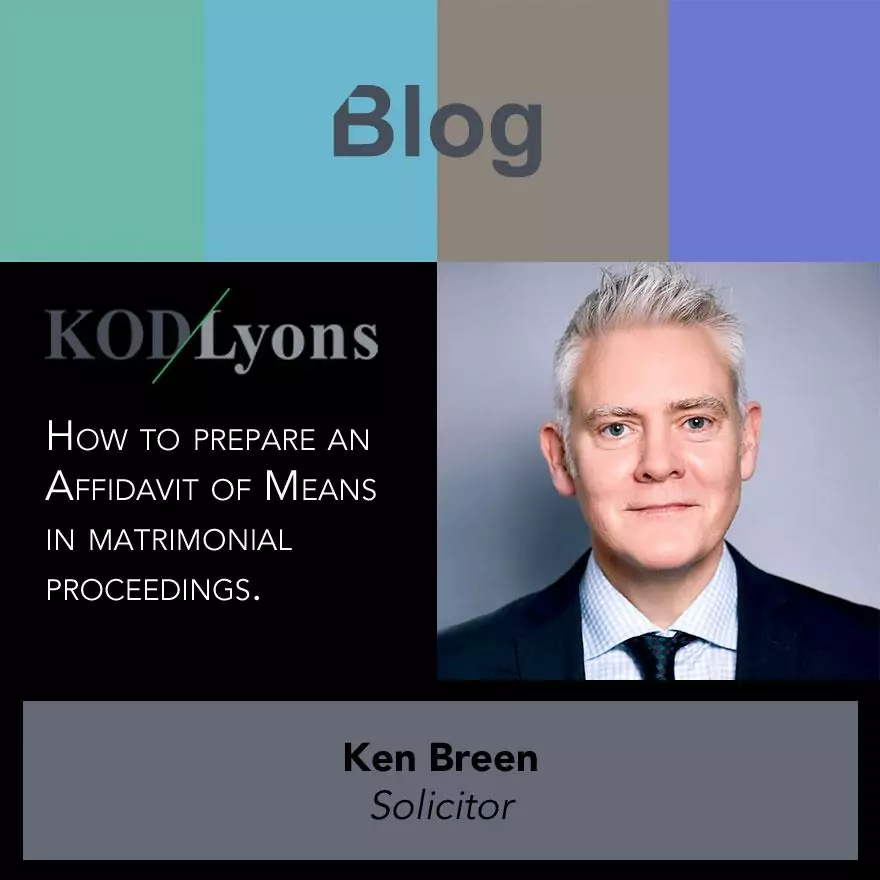When I first speak with a person about a relationship breakdown, separation or divorce, I spend considerable time speaking with them, listening and exploring the history of the relationship. I try to establish a picture of the family unit and its dynamics and I try to look at how best to advise that person and explore the right options for them in their own particular circumstances.
I would actively explore with the person whether there are any prospects of a reconciliation and if that is not possible we discuss the various forms of possible engagement with a view to trying to work out how the estranged parties can try to live separate and apart going forward. This could involve processes such as mediation, negotiation or legal proceedings.
There will typically be a variety of matters to consider – co-parenting arrangements and issues, accommodation needs and requirements and of course the family assets and finances. This is where the Affidavit of Means comes in and this is the focus of this particular article.
An Affidavit is sworn testimony so the person swearing it must ensure that they are satisfied that it is accurate in every respect. It is evidence and open to cross-examination.
The Rules of Court direct the format of the Affidavit of Means and essentially it is divided into 5 separate sections or schedules’
- ASSESTS – the first section of the Affidavit of Means is to provide a list of all the assets of the person swearing the Affidavit (the Deponent). This typically includes the family home and any real property assets such as, for example, investment property or rented property. It also sets out details of all/any bank accounts with account numbers and balances. This section should also list all/any shareholdings, commercial business assets or investments & insurance policies, Credit Union accounts, vehicles or other various valuables. I am often asked how a person can value the contents of their family home. This is not easy but a good place to start is to have a look at your household policy of insurance and see what sum the contents are insured for.
- INCOME – the second section sets out details of a Deponent’s income from ALL sources – salaries, investment earnings, dividend income and any State Payments received, such as, for example, Child Benefit. Typically, the details should provide GROSS & NETT annual and monthly amounts.
- DEBTS/LIABILITIES – the third section lists all/any mortgages, loans, debts or credit card liabilities.
- PERIODIC EXPENDITURES – this section typically provides a person with the most ‘homework’. Essentially, the person needs to examine their spending over a period of time, such as for example, the previous 12 months and itemise where their money is spent. This typically involves detailed analysis of bank statements and household bills and grocery expenses. So called ‘big ticket’ items are usually pretty straight forward – mortgage/rent, car loans, insurances, education, creche/childcare, utilities, vehicles and so forth but expenditures associated with every day living such as food, travel and the many every day expenses may take a bit of time to assess and calculate.
- PENSIONS – this section provides for a list of all pension plans or policies and typically sets out the valuations of each.
It is important to note that the Affidavit of Means is not a stand alone document. It must be supported with ‘back up documentation’ or ‘vouching’ as it may be termed. Typically, this will include bank statements for all accounts, evidence of shareholdings, business accounts and documentation, property valuations, credit card statements, Employment Summary Details and payslips, tax returns and assessments, financial institution documentation showing all/any sums owed and of course pension plan details showing typically, the rules of the pension scheme and the most recent Statement of Benefits and the value of the policy or plan.
Accordingly, as you can see there is quite a lot of information and documentation required to assess and examine in the preparation of an Affidavit of Means. It is usual for both parties to prepare and exchange vouched Affidavits of Means so that an accurate family financial profile can be established and this is an essential requirement and a prerequisite for any informed discussion around models of resolution arising from relationship or marital breakdown.
Get in touch
Leaders in our field and winners at the Irish Law awards we have proven expertise in immigration and international law, child and family law and personal injury litigation.
Tel: +353 1 679 0780
Email: info@kodlyons.ie








